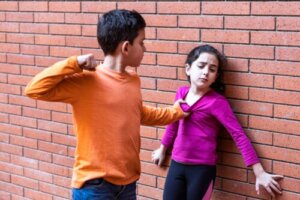Why Do Children Become Violent?

We know that anger and rage are healthy emotions: We need to get angry and show disagreement in the face of those situations that we experience as unfair. However, what’s the boundary between anger and violence at an early age? How do you prevent it from escalating into aggressive behavior? Why do children become violent?
For many parents, these are questions that arise when they’re faced with a child who seems to be starting to act violently. There are several factors to consider. Let’s see what they are in this article.
Some factors that cause children to become violent
Although they’re not determining causes and each child will react differently to the circumstances, there are some factors that collaborate in the development of aggressive behaviors. Among them, we find the following:
- Overly authoritarian parenting. Parental styles have a great influence on children’s behavior. The education they receive works as an example, as certain behaviors are naturalized. As a result, those values and ways of proceeding that the children observe can become the model to follow.
- The child lives in a hostile and violent context. This is produced, for example, when the child’s humiliated on a daily basis, when they’re constantly mistreated, or if their achievements or needs are underestimated. Also, when they witness situations of violence between their parents.
- They suffer bullying at school. Sometimes, children who are bullied at school may develop aggressive behaviors in other areas.
You may be interested in: 5 Strategies for Managing Aggression in Children
What behaviors should we pay attention to?
Although they’re not the only ones, nor are they decisive, some signs that invite us to pay more attention to our child’s behavior are the following:
- The child shows constant anger and rage.
- They often respond with insults or make aggressive faces. Sometimes, they react by kicking, pinching, or spitting.
- They find it difficult to communicate without aggression. At the same time, when they’re spoken to, they feel annoyed.
- The child objects to complying with rules at home and in other settings.

Recommendations to prevent children from becoming violent
Some keys to preventing children from developing aggressive behaviors are mentioned below.
Take into account the child’s age
At a certain age, emotional outbursts are frequent because children still don’t know how to handle frustration, which is often the cause of anger. However, from the age of 6 or 7, if their violent behavior is the common response to all situations, then you should pay attention.
Understand and look for the cause of their behavior
In this regard, not only do you need to have a dialogue with the child, but also to take into account all the information that the context can provide.
Encourage the expression of emotions
It’s important to help children identify how they feel in order to express themselves. When they manage to put a name to that burst of emotions in front of a situation that they experience as unfair or unpleasant, they can learn to react in a better way.
The accompaniment or guidance of an adult is essential, especially in the first years of childhood, as some areas of the brain, which have impulse control functions, are still developing. To talk about what’s happening to them, resources such as reading stories or doing breathing exercises can be used to help them regulate themselves.
Promote values in education
The idea is for children to be able to function in any environment so that when they’re not at ease, they know how to set limits or remove themselves from the problem. Applying those values that are instilled at home will surely help them to resolve situations without resorting to violence.
Take care of the treatment between parents
Avoiding arguing in front of your children is a good way to protect them from the hostile environment that’s produced and then absorbed by them. Likewise, you need to try to keep calm with children and not offer violent answers, even when you’re angry or they’ve caused some sort of trouble.

Other recommendations
Some additional recommendations that can be useful to act when you notice that your child reacts in a violent way are the following:
- Intervene in time with limits. If you notice that the child is getting violent with a peer, is about to break an object, or is mistreating a pet, it’s important to intervene and stop the behavior immediately.
- Reinforce desired and positive behaviors. This way, the child will be able to identify the emotions produced when they behave appropriately and feel recognized.
- Offer alternatives for conflict resolution. It’s our responsibility as adults to teach them to talk, negotiate, and ask for help when they find themselves in an unpleasant situation, instead of encouraging the use of violence.
- Be consistent with the limits you set. Letting things slide on some occasions and intervening on others sends ambiguous messages that don’t contribute to consolidating what we want the child to do or not do.
You may be interested in: What Is Sudden Childhood Aggression?
Labels don’t help
When we’re faced with behavioral problems in children, it’s important to deal with the issue, but also to think that it’s usually something transitional. Many times, parents are left with the idea that their child is violent and hold onto a label that stigmatizes them and leaves them prisoners of this idea.
However, if there’s something that characterizes childhood, it’s plasticity and flexibility. Children are able to learn, correct, and develop new habits and behaviors. For this reason, we must avoid labels that, far from building them up actually destroy and attack their self-esteem and make them believe that change isn’t worthwhile.
Finally, it’s always good to ask ourselves how we’re raising our children, review our own behaviors, and be aware of the type of education we’re giving our children based on our way of proceeding.
We know that anger and rage are healthy emotions: We need to get angry and show disagreement in the face of those situations that we experience as unfair. However, what’s the boundary between anger and violence at an early age? How do you prevent it from escalating into aggressive behavior? Why do children become violent?
For many parents, these are questions that arise when they’re faced with a child who seems to be starting to act violently. There are several factors to consider. Let’s see what they are in this article.
Some factors that cause children to become violent
Although they’re not determining causes and each child will react differently to the circumstances, there are some factors that collaborate in the development of aggressive behaviors. Among them, we find the following:
- Overly authoritarian parenting. Parental styles have a great influence on children’s behavior. The education they receive works as an example, as certain behaviors are naturalized. As a result, those values and ways of proceeding that the children observe can become the model to follow.
- The child lives in a hostile and violent context. This is produced, for example, when the child’s humiliated on a daily basis, when they’re constantly mistreated, or if their achievements or needs are underestimated. Also, when they witness situations of violence between their parents.
- They suffer bullying at school. Sometimes, children who are bullied at school may develop aggressive behaviors in other areas.
You may be interested in: 5 Strategies for Managing Aggression in Children
What behaviors should we pay attention to?
Although they’re not the only ones, nor are they decisive, some signs that invite us to pay more attention to our child’s behavior are the following:
- The child shows constant anger and rage.
- They often respond with insults or make aggressive faces. Sometimes, they react by kicking, pinching, or spitting.
- They find it difficult to communicate without aggression. At the same time, when they’re spoken to, they feel annoyed.
- The child objects to complying with rules at home and in other settings.

Recommendations to prevent children from becoming violent
Some keys to preventing children from developing aggressive behaviors are mentioned below.
Take into account the child’s age
At a certain age, emotional outbursts are frequent because children still don’t know how to handle frustration, which is often the cause of anger. However, from the age of 6 or 7, if their violent behavior is the common response to all situations, then you should pay attention.
Understand and look for the cause of their behavior
In this regard, not only do you need to have a dialogue with the child, but also to take into account all the information that the context can provide.
Encourage the expression of emotions
It’s important to help children identify how they feel in order to express themselves. When they manage to put a name to that burst of emotions in front of a situation that they experience as unfair or unpleasant, they can learn to react in a better way.
The accompaniment or guidance of an adult is essential, especially in the first years of childhood, as some areas of the brain, which have impulse control functions, are still developing. To talk about what’s happening to them, resources such as reading stories or doing breathing exercises can be used to help them regulate themselves.
Promote values in education
The idea is for children to be able to function in any environment so that when they’re not at ease, they know how to set limits or remove themselves from the problem. Applying those values that are instilled at home will surely help them to resolve situations without resorting to violence.
Take care of the treatment between parents
Avoiding arguing in front of your children is a good way to protect them from the hostile environment that’s produced and then absorbed by them. Likewise, you need to try to keep calm with children and not offer violent answers, even when you’re angry or they’ve caused some sort of trouble.

Other recommendations
Some additional recommendations that can be useful to act when you notice that your child reacts in a violent way are the following:
- Intervene in time with limits. If you notice that the child is getting violent with a peer, is about to break an object, or is mistreating a pet, it’s important to intervene and stop the behavior immediately.
- Reinforce desired and positive behaviors. This way, the child will be able to identify the emotions produced when they behave appropriately and feel recognized.
- Offer alternatives for conflict resolution. It’s our responsibility as adults to teach them to talk, negotiate, and ask for help when they find themselves in an unpleasant situation, instead of encouraging the use of violence.
- Be consistent with the limits you set. Letting things slide on some occasions and intervening on others sends ambiguous messages that don’t contribute to consolidating what we want the child to do or not do.
You may be interested in: What Is Sudden Childhood Aggression?
Labels don’t help
When we’re faced with behavioral problems in children, it’s important to deal with the issue, but also to think that it’s usually something transitional. Many times, parents are left with the idea that their child is violent and hold onto a label that stigmatizes them and leaves them prisoners of this idea.
However, if there’s something that characterizes childhood, it’s plasticity and flexibility. Children are able to learn, correct, and develop new habits and behaviors. For this reason, we must avoid labels that, far from building them up actually destroy and attack their self-esteem and make them believe that change isn’t worthwhile.
Finally, it’s always good to ask ourselves how we’re raising our children, review our own behaviors, and be aware of the type of education we’re giving our children based on our way of proceeding.
All cited sources were thoroughly reviewed by our team to ensure their quality, reliability, currency, and validity. The bibliography of this article was considered reliable and of academic or scientific accuracy.
- Armero Pedreira, P., Bernardino Cuesta, B., & Bonet de Luna, C.. (2011). Acoso escolar. Pediatría Atención Primaria, 13(52), 661-670. https://dx.doi.org/10.4321/S1139-76322011000600016
- Heras Sevilla, Davinia, & Cepa Serrano, Amaya, & Lara Ortega, Fernando (2016). DESARROLLO EMOCIONAL EN LA INFANCIA. UN ESTUDIO SOBRE LAS COMPETENCIAS EMOCIONALES DE NIÑOS Y NIÑAS. International Journal of Developmental and Educational Psychology, 1(1),67-73.[fecha de Consulta 11 de Enero de 2022]. ISSN: 0214-9877. Disponible en: https://www.redalyc.org/articulo.oa?id=349851776008
This text is provided for informational purposes only and does not replace consultation with a professional. If in doubt, consult your specialist.








